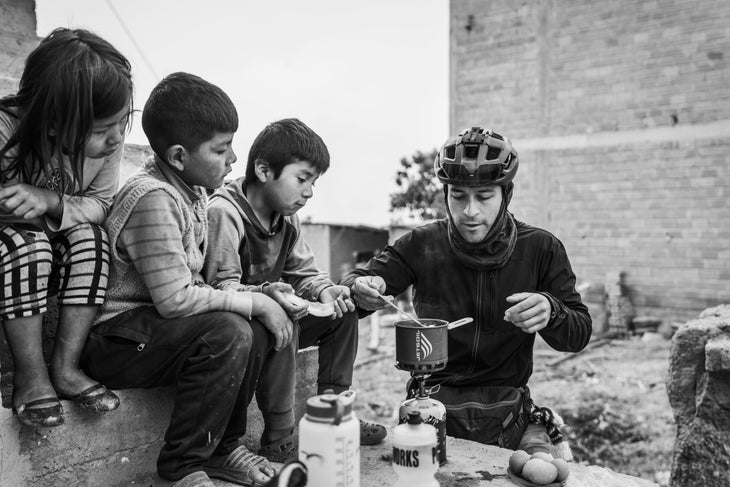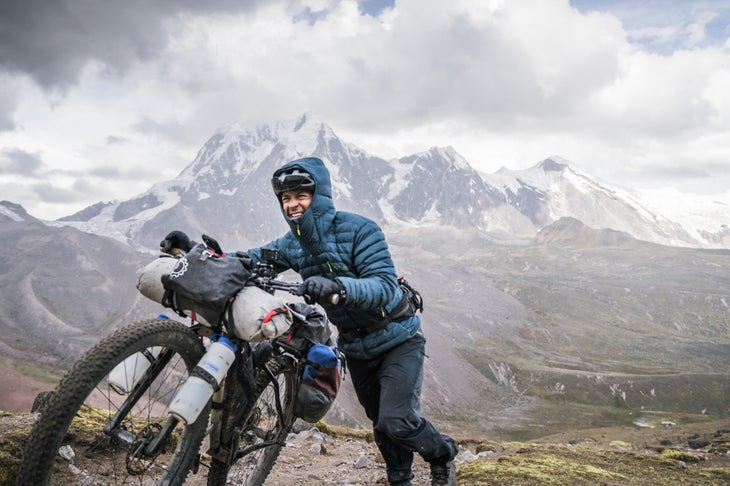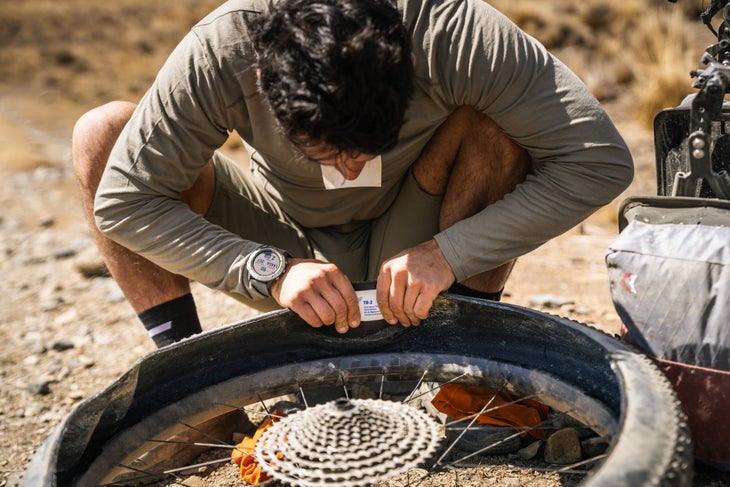“],”filter”:{“nextExceptions”:”img, blockquote, div”,”nextContainsExceptions”:”img, blockquote, a.btn, a.o-button”},”renderIntial”:true,”wordCount”:350}”>
Picture the Peruvian Andes: rugged peaks, 16,000-foot passes, remote landscapes, and adventure opportunities abound. But for two ambitious bikepackers, the area’s allure was about more than just its natural beauty. When Rab athlete and photographer Leonardo Brasil and endurance athlete and documentarian Adam Andres Pawlikiewicz Mesa decided to traverse the Qhapaq Ñan from La Paz, Bolivia, to Cusco, Peru, they were following a desire to learn more about the locals and themselves. Over 37 days, the pair was immersed in heritage, culture, and history—an experience they agree was thanks to the slow simplicity of bikepacking. Here’s their take on the experience.
The pair rode at an average elevation of nearly 15,000 feet and climbed multiple passes at 16,000 feet. (Photo: Leonardo Brasil)
Outside: What is the Qhapaq Ñan, and what inspired you to bikepack it?
Leonardo Brasil: I was born and raised in Brazil and was lucky to have lived in Colorado, USA, for ten years before moving back to my hometown of Rio de Janeiro. Since I never owned a vehicle, I found my passion for bikepacking while living abroad as a natural evolution of my curiosity to experience different cultures and see places. Exploring South America, the continent that I’m from, was the next obvious step. My goal was to understand a bit more about our Hispanic neighbors—since Brazil is the only Portuguese-speaking country over there—and to experience their way of life both as a human on this earth and as a photographer and storyteller.
Adam Andres Pawlikiewicz Mesa: Translated from Quechua, the “Royal Road” once united all Andean communities from Colombia to Chile in an intricate road system of more than 18,600 miles. Constructed by the Incas over several centuries—and partly based on pre-Inca infrastructure—this extraordinary network navigates one of the world’s most extreme geographical terrains. It links the snowcapped peaks of the Andes—at an altitude of more than 19,600 feet—to the coast. Along the way, it runs through hot rainforests, fertile valleys, and absolute deserts. In 2014, it became an UNESCO World Heritage site. As a bikepacker and documentarian, I wanted to celebrate this rich history and to celebrate this part of my identity and ancestry in a way that made sense to me.
 Curious children watch as Adam shows them how he prepares his meals on the trail. (Photo: Leonardo Brasil)
Curious children watch as Adam shows them how he prepares his meals on the trail. (Photo: Leonardo Brasil)
What was your favorite experience on the Qhapaq Ñan?
Leonardo: For the most part, locals speak Aymara in the mountains of Bolivia and Quechua in Peru, and Spanish is their second language—just as is mine. Being able to share a bit about my life with the people I met and to learn about their culture in return was an invaluable experience. One particular moment comes to mind: It was around day ten, when we left Sorata and began the long climb on the Ruta de las Tres Cordilleras. We arrived at a town called Pocobaya around 4 p.m.—around when we normally began looking for a camp. We asked a local if we could camp on their soccer field. A few hours later, after we had set up our tent, all the kids began to show up to investigate us. They were curious about everything—our bikes, our tent, how we made food on our tiny stoves, and why I “didn’t talk properly.” But one common interest united us all: soccer.
Adam: One of my favorite experiences on the Qhapaq Ñan was about two weeks into the journey. We happened upon a few ranchers with their alpaca near the small village of Inca Capaturi. I noticed from afar that they were appearing to be shearing the fur of the animals. Eventually, we realized that they were actually processing the animals, right there in an open field. Curious, I wanted to engage, but since we were in such a remote area, we approached cautiously. It ended up being a family endeavor, and everyone welcomed us into the experience. Nelson, one of the ranchers, shared that in this part of the world, the natives save the blood of the animals and, later on, pour the blood at the entrance of the mines to bless passage and bring good luck to the miners.
How did you select your kits for such a long bikepacking expedition?
Leonardo: We carefully chose each piece of our gear with two important qualifications in mind: the durability to withstand the abuse of a monthlong traverse in desolated territory and the versatility to adapt to the ever-changing weather we expected to face at 16,000 feet. We carried very light cycling kits. For clothes, we relied on essential pieces:
Rab Force Hoody: Soft, breathable, and quick-drying, this hoodie was perfect for everyday wear.
Cinder Crank Shorts: Made from a breathable softshell fabric, these shorts delivered all-day comfort with thigh venting zips for further ventilation and saddle reinforcements for durability.
Cinder Downpour Light Waterproof Pants: These packable waterproof biking pants offered unmatched comfort in the saddle and reliable protection whenever the weather would turn.
Infinity Microlight Down Jacket: Insulated with 700 fill power 100 percent recycled down, this reliably warm jacket was the perfect layer for nights at camp.
 The Rab Infinity Microlight Down Jacket uses lightweight and breathable GORE-TEX INFINIUM
The Rab Infinity Microlight Down Jacket uses lightweight and breathable GORE-TEX INFINIUM WINDSTOPPER® and offers the perfect protection for alpine adventure. (Photo: Leonardo Brasil)
WINDSTOPPER® and offers the perfect protection for alpine adventure. (Photo: Leonardo Brasil)
We also carried the Mythic 400 Down Sleeping Bag (21°F) for comfortable warmth in the varying high-alpine conditions. Here’s a video of all the gear we carried on our expedition.
Along your journey, what was the greatest challenge you faced, and how did you overcome it?
Adam: Our greatest challenge was the injury I endured at nearly 17,000 feet. About 30 miles from the finish of our planned route and just after summiting a rocky mountain pass, I crashed. We bundled up at the top as it began to hail. We were excited for a large descent after eight hours of pushing our bikes uphill. Leonardo was ahead of me as I photographed from behind. I excitedly started riding after him but quickly lost control and clipped a large boulder to my right. In an attempt to correct, I pulled the bike left and immediately flipped over my handlebars, landing in a field of scree—my left wrist absorbing the impact. I heard a crack, and a surge of pain radiated through my whole body. Leonardo rushed to me. And as we began to investigate, we realized that I had fractured my wrist. Over the next 48 hours, we pushed our bikes to the nearest path-turned-road until we arrived at a town that offered a bus to Cusco.
 Things are not going to go as planned (they rarely do). (Photo: Leonardo Brasil)
Things are not going to go as planned (they rarely do). (Photo: Leonardo Brasil)
What advice would you give to someone who’s interested in planning a similar adventure?
Leonardo: Be open-minded. Things are not going to go as planned—they rarely do—and the best approach anyone could have in these situations is to adapt and move on. What would you do if you slash your tire beyond repair in the middle of nowhere on the fifth day of a monthlong expedition? What would you do if you unexpectedly ride for six days without finding a single tienda to resupply and you are running dangerously low on food? What would you do if your partner crashes and breaks his arm at nearly 16,000 feet and the next town is a day away? You can’t plan for all possible scenarios, and you need to be okay with that. That’s the beautiful nature of adventure.
Adam: Set an intention, but similar to Leonardo’s advice, remain flexible. The fuel for these adventures is the desire to learn more about yourself and the world around you. With that in mind, the “destination” or “goal” is rather flexible. As long as you grow from the experience, it’s a win in my book.
More than 40 years since our founding, Rab continues to find inspiration in the untamed spirit of the mountains where we climb, the friendships we forge on the peak, and our enduring mission: to grow our community of mountain people and equip them for adventure.
We are committed to putting people at the heart of what we do. From our partners and athletes to our staff and everyone who has used and loved our gear, we are a global community that goes beyond mountains and crags, and it’s up to us to make sure it’s inclusive, diverse, and growing.
Author :
Publish date : 2024-06-13 02:00:00
Copyright for syndicated content belongs to the linked Source.
—-
Author : theamericannews
Publish date : 2024-06-13 20:54:15
Copyright for syndicated content belongs to the linked Source.